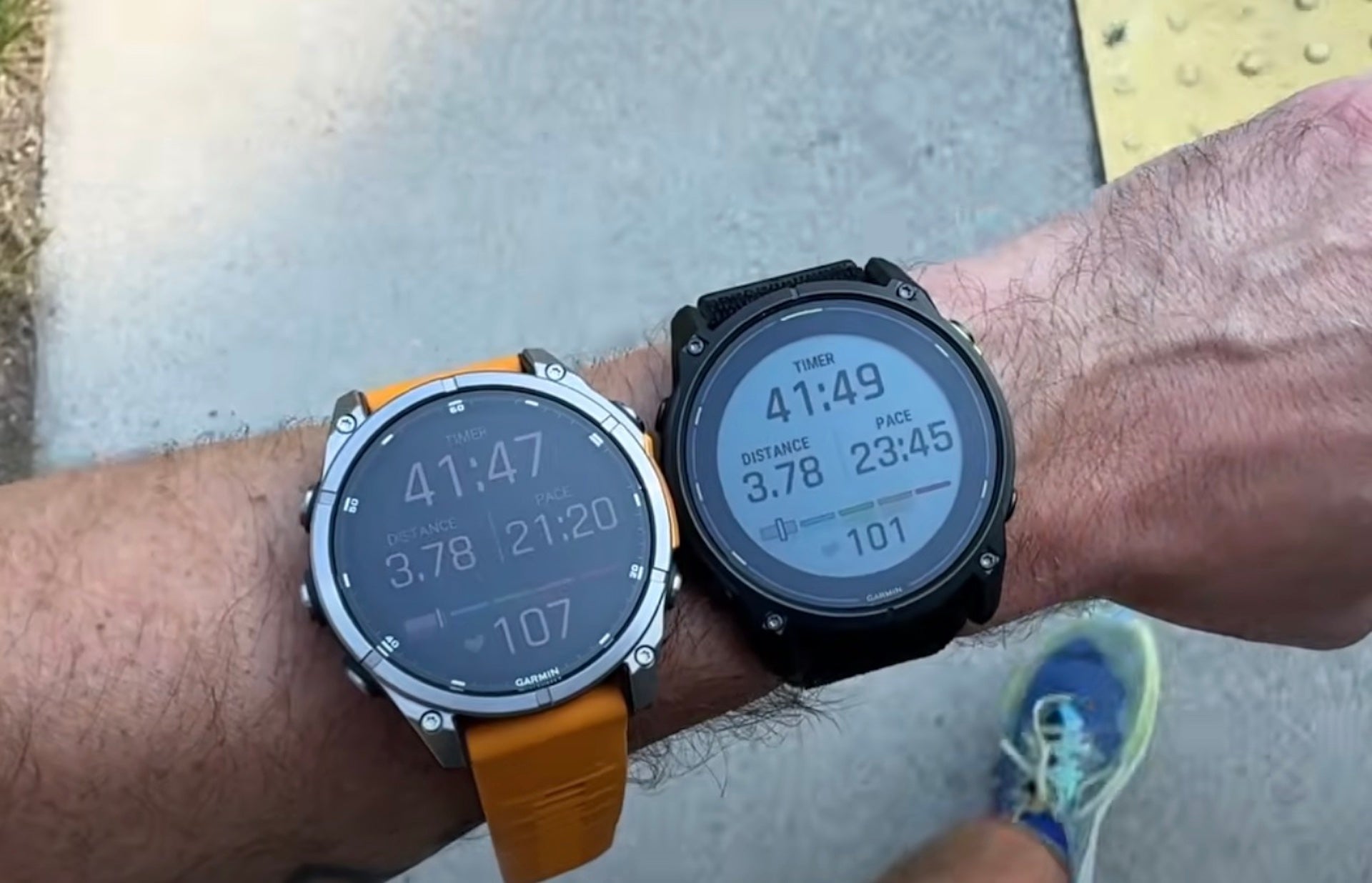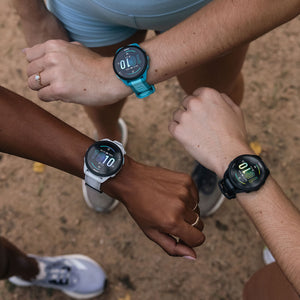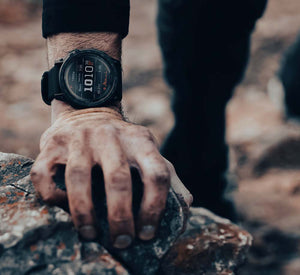
Garmin Enduro 3 vs fenix 8 Series: An In-Depth Look at the Feature Trade-Offs
With so much Garmin DNA in common, it's the differences in these premium multisport watches that matter. Compare the Garmin fenix 8 vs Enduro 3 to find out which one aligns more closely with your needs!
This year, Garmin released two exceptional new watches in the premium multisport segment on the same day: the Enduro 3 and the fenix 8.
The Enduro 3 is an ultraperformance watch purpose-built for hardcore ultra runners and backcountry explorers. The fenix 8 is the most premium multisport watch on the market created for runners of all stripes: marathon, triathlon, ultra, trail ... you name it. It strikes the perfect balance between durability and sophistication.
Overall, these flagship Garmin watches have way more in common than not. In nearly every category—GPS, Maps and Navigation, Training Features, Health Monitoring, Sports Apps—they are identical.
But the few differences are significant, depending on how you want to use your watch.
To figure out which choice is right for you, you're going to need to know the glaring and more subtle differences between these two Garmin watches. Let's get to it!
Table of Contents
- What’s New on the Enduro 3 vs Enduro 2
- What’s New on the fenix 8 vs fenix 7 Pro
- Common Features Between the fenix 8 and Enduro 3
- Garmin Enduro 3 vs fenix 8 Price Comparison
- Size/Weight Comparison Table
- AMOLED Display vs MIP with New Solar Panel
- Garmin Enduro 3 vs fenix 8 Battery Life
- Durability
- Garmin fenix 8 vs Enduro 3 — Which One?
What’s New on the Enduro 3 vs Enduro 2
Perhaps the biggest surprise about this watch is that it’s $100 less than the previous Enduro 2! Here’s what’s new and improved:
- Unbeatable battery life of up to 320 hours in GPS mode using solar charging in 50k lux conditions.
- Thinner titanium bezel and unibody housing equals a lightweight design at just 63 grams.
- New solar panel for improved solar-charging efficiency and display visibility.
- Dynamic round-trip routing.
- Sport-specific strength workouts tailored for runners, cyclists, hikers, and more.
- Gen 5 HR with ECG.
- Updated user interface and menus structure.
- Lower starting price vs Enduro 2 launch price.
Get more details in this in-depth look at the Enduro 3 ultra-endurance watch.
What’s New on the fenix 8 vs fenix 7 Pro
The new Garmin fenix 8 is a formidable multisport masterpiece as it finally puts some of the most coveted features in one premium smartwatch. Here’s the list of all the new stuff:
- AMOLED display options. Solar-charging option with MIP display available for 47 mm and 51 mm only.
- Integrated speaker and microphone (previously only on the Garmin Venu 2 Plus & Venu 3) for phone calls, voice assistant access, off-line voice control, and voice memo creation.
- An LED flashlight is now standard on all fenix 8 sizes (43 mm, 47 mm, and 51 mm).
- Garmin’s already industry-leading maps and navigation have been improved.
- New user interface and improved watch face editor.
- New leak-proof buttons and sensor guard.
- Display size increases on 43mm (1.3”) and 47mm (1.4”).
- Outdoor Maps+ compatibility.
- Adaptive round-trip routing.
- Ski/Snowboard difficulty tracking.
- Strength Training Plans (found inside Garmin Coach on GCM).
- Sport Specific Workouts (found inside GCM > Training/Planning > Workouts).
- Rec scuba diving.
- The addition of the AMOLED display and speaker/mic, make this generation of Garmin fenix watches more expensive.
Read a Garmin fenix 8 review from a serious runner!
Read more details on the 2025 Garmin fenix 8 series of multisport watches.
Compare the fenix 8 with the fenix 7 Pro, epix (Gen 2) Pro, and fenix E.
Common Features Between the fenix 8 and Enduro 3
The Enduro 3 and fenix 8 lineup have a common core of Garmin DNA between them, including:
- Rugged, premium build quality
- Highly responsive color touchscreen
- Improved user interface
- Same GPS chipset and antenna design (multi-frequency, SATIQ™ technology)
- Gen 5 heart rate sensor capable of ECG and skin temp features
- Built-in LED flashlight
- All of Garmin best training and health-monitoring features
Garmin Enduro 3 vs fenix 8 Price Comparison
| fenix 8 43 mm* | fenix 8 47 mm | fenix 8 51 mm | Enduro 3 51 mm** | |
| AMOLED Glass |
$999.99 | $999.99 | $1099.99 | N/A |
| AMOLED Sapphire |
$1099.99 | $1099.99 | $1199.99 | N/A |
| Solar Sapphire |
N/A | $1099.99 | $1199.99 | $899.99 |
*The smallest fenix 8 (43 mm) does not have a solar-charging option.
**The Enduro 3 only comes in one size — 51 mm.
(image of Dave holding the Enduro 3 and fenix 8 from his Chase the Summit comparison video)
Size/Weight Comparison Table
| fenix 8 43 mm | fenix 8 47 mm AMOLED (A) / Solar (S) |
fenix 8 51 mm AMOLED (A) / Solar (S) |
Enduro 3 (51 mm) |
|
| Case Size |
43 x 13.8 mm |
47 x 13.8 mm (A) |
51 x 14.7 mm (A) 51 x 15.4 mm (S) |
51 x 15.7 mm (Sapphire Solar Only) |
| Weight |
Stainless Steel: 66 g |
SS: 80 g (A) |
SS: 102 g (A) |
63 g (titanium only) |
| Display |
1.3" AMOLED |
1.4" (A) |
1.4" (A) |
1.4" |
AMOLED Display vs MIP with New Solar Panel
In reality, there are pros and cons to both displays. AMOLED displays are beautiful and vibrant when they are on, but they take a lot of power to drive that display. Because of this, they are not truly always-on displays. You can set your Garmin watch with AMOLED to be always-on, but even then they will dim down to conserve battery life and to be easier on the eyes.
The MIP display is a true always-on display. Because it uses so little power, it is on all the time. But the display itself does not emit light, so with the backlight off it can be hard to see in certain lighting conditions.
Some runners and outdoor enthusiasts have become partial to an AMOLED screen because you can see your watch face better in conditions like heavy cloud cover and under dense trees.
Also, an AMOLED display has millions of colors, and therefore is capable of things like gradients. The MIP display only has 64 colors at its disposal and is therefore more limited when rendering images.
As for the MIP displays on the Enduro 3 and the options on the fenix 8 – 47 mm & 51 mm Solar models, the solar panel has been improved and thus the clarity of the display has been improved.
To see the difference between the two displays side by side, Check out this YouTube video from our partner, Chase the Summit.
Garmin Enduro 3 vs fenix 8 Battery Life
While the Garmin Enduro 3 battery life, especially with solar-charging, is unbeatable, it's important to note that the fenix 8 series offers battery life that is quite competitive with other watches on the market.
Still, if you want a premium sport watch that can go weeks without plugging it in to charge, the Enduro 3 is the only way to go!
Garmin Enduro 3 Battery Life:
- Smartwatch: Up to 36 days/90 days with solar
- Battery Saver Watch Mode: Up to 92 days/unlimited with solar
- GPS Only: Up to 120 hours/320 hours with solar
- All Satellite Systems: Up to 80 hours/144 hours with solar
- All Satellite Systems + Multi-band: Up to 60 hours/90 hours with solar
- All Satellite Systems + Music: Up to 22 hours
- Max Battery GPS: Up to 210 hours/unlimited with solar
- Expedition GPS: Up to 77 days/unlimited days with solar
fenix 8 AMOLED 43 mm:
- Smartwatch: Up to 10 days (4 days always-on)
- Battery Saver Watch Mode: Up to 15 days
- GPS Only: Up to 28 hours (22 hours always-on)
- All Satellite Systems: Up to 23 hours (18 hours always-on)
- All Satellite Systems + Multi-band: Up to 21 hours
- All Satellite Systems + Music: Up to 6 hours
- Max Battery GPS: Up to 49 hours
- Expedition GPS: Up to 10 days
fenix 8 AMOLED 47 mm:
- Smartwatch: Up to 16 days (7 days always-on)
- Battery Saver Watch Mode: Up to 23 days
- GPS Only: Up to 47 hours (37 hours always-on)
- All Satellite Systems: Up to 38 hours (30 hours always-on)
- All Satellite Systems + Multi-band: Up to 35 hours (28 hours always-on)
- All Satellite Systems + Music: Up to 10 hours
- Max Battery GPS: Up to 81 hours
- Expedition GPS: Up to 17 days
fenix 8 Solar 47 mm:
- Smartwatch: Up to 21 days/28 days with solar
- Battery Saver Watch Mode: Up to 34 days/58 days with solar
- GPS Only: Up to 67 hours/92 hours with solar
- All Satellite Systems: Up to 48 hours/59 hours with solar
- All Satellite Systems + Multi-band: Up to 37 hours/43 hours with solar
- All Satellite Systems + Music: Up to 13 hours
- Max Battery GPS: Up to 132 hours/283 hours with solar
- Expedition GPS: Up to 34 days/58 days with solar
fenix 8 AMOLED 51 mm:
- Smartwatch: Up to 29 days (13 days always-on)
- Battery Saver Watch Mode: Up to 41 days
- GPS Only: Up to 84 hours (65 hours always-on)
- All Satellite Systems: Up to 68 hours (54 hours always-on)
- All Satellite Systems + Multi-band: Up to 62 hours (49 hours always-on)
- All Satellite Systems + Music: Up to 18 hours
- Max Battery GPS: Up to 145 hours
- Expedition GPS: Up to 31 days
fenix 8 Solar 51 mm:
- Smartwatch: Up to 30 days/48 days with solar
- Battery Saver Watch Mode: Up to 48 days/107 days with solar
- GPS Only: Up to 95 hours/149 hours with solar
- All Satellite Systems: Up to 68 hours/92 hours with solar
- All Satellite Systems + Multi-band: Up to 52 hours/65 hours with solar
- All Satellite Systems + Music: Up to 18 hours
- Max Battery GPS: Up to 186 hours/653 hours with solar
- Expedition GPS: Up to 50 days/118 days with solar
Durability
Both of these Garmin multisport watches are purpose-built for durability, making them superior in the ruggedness department.
Like most Garmin watches, they are all-weather ready, built to U.S. military standard 810 for thermal, shock, and water resistance.
The Garmin Enduro 3 features a scratch resistant power sapphire lens and a rugged titanium bezel. Certain options in each size of the fenix 8 lineup offer the same.
The fenix 8, however, takes it a step further. A new sensor guard and leak-proof buttons turn this multisport watch into a dive watch with a 40-meter rating.
Garmin fenix 8 vs Enduro 3 — Which One?
To recap, you will likely choose the Enduro 3 ultra-endurance watch over the fenix 8 if:
- You prize battery life above all else.
- You're willing to live without the AMOLED display.
- You don't care about making calls or using voice commands with your watch.
- You're cool with the one large size option.
- You want to get nearly everything that is on the fenix 8 but for up to $300 less!
You will likely go the Garmin fenix 8 advanced running watch if:
- AMOLED display is a must have.
- You really want the new speaker/mic integration for using voice commands and making calls from your wrist (needs to be paired with phone for calling).
- You want the new dive app which includes the sensor guard.
- You either don't mind charging up your watch every few days (depending on use) or you will get the MIP Solar option (no AMOLED display) and have better battery life along with the mic/speaker.
- You want the 43 mm or 47 mm size options.
- Money is not a factor.
We did not mention the most affordable option that came out with the fenix 8 series—the Garmin fenix E. This is a fenix 8 with an AMOLED display but without the speaker and mic and dive app features. It has less durability than the fenix 8 and less battery life than an Enduro 3. But it does only cost $799.99.
While these watches have so many of Garmin's amazing features in common, there are trade-offs. We hope you understand them well enough now to make a decision between two of the best Garmin watches ever made!

















